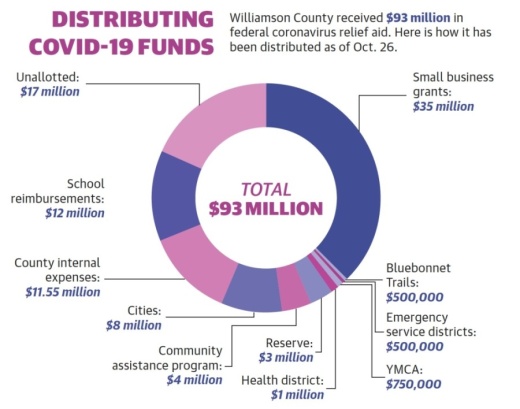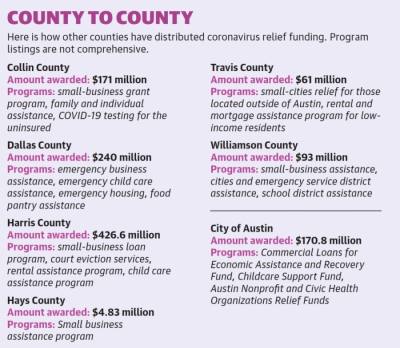“I dare to say that any county in America has accomplished what we’ve accomplished in the last six months,” Williamson County Judge Bill Gravell said during an October meeting. “We have done an amazing job through a global pandemic to help our county not only stand up but to run forward.”
The Coronavirus Aid, Relief and Economic Security Act, or CARES Act, was a $2 trillion stimulus bill passed in March with the intent of financially helping people and entities devastated by the coronavirus pandemic.
Williamson County was an early adopter of ramping up distribution points, starting with small businesses in May. The program, which funneled money to local businesses with fewer than 100 full-time employees, was allotted the largest portion of the total, at $35 million, Williamson County Treasurer Scott Heselmeyer said.
As of Oct. 30 the county had also distributed about $500,000 to cities, to which $8 million is currently allocated; $85,000 to emergency service districts, to which $500,000 is allocated; $1 million for community rent and utility assistance, to which $4 million is allocated; and a pending $1.5 million to schools, to which $12 million is allocated. Heselmeyer said he believes an extension is pending, but as of Oct. 30, any unspent money by the current Dec. 30 deadline will need to be returned to the federal government.
“We want to do everything we can to help our citizens, our constituents, with these COVID-related expenses,” Heselmeyer said. “[We want to] make sure that their cities are taken care of, make sure that their schools are taken care of ... and utilize this money to the maximum extent.” While there are some parameters for how the money can be distributed, counties and cities are autonomous in deciding how much, when, how and to whom the money goes.
Travis County received $61 million in CARES Act funding, which it allocated toward small-cities relief for entities located outside of Austin and toward rental and mortgage assistance for low-income residents. Harris County, with $426.6 million in funds, started court eviction and child care assistance programs, among other efforts.
“It may be federal government taxpayer dollars, but that’s still taxpayer dollars,” Heselmeyer said. “We are still placing the same priorities on being responsible. We spend that money as we would if it was property tax money collected locally.”






